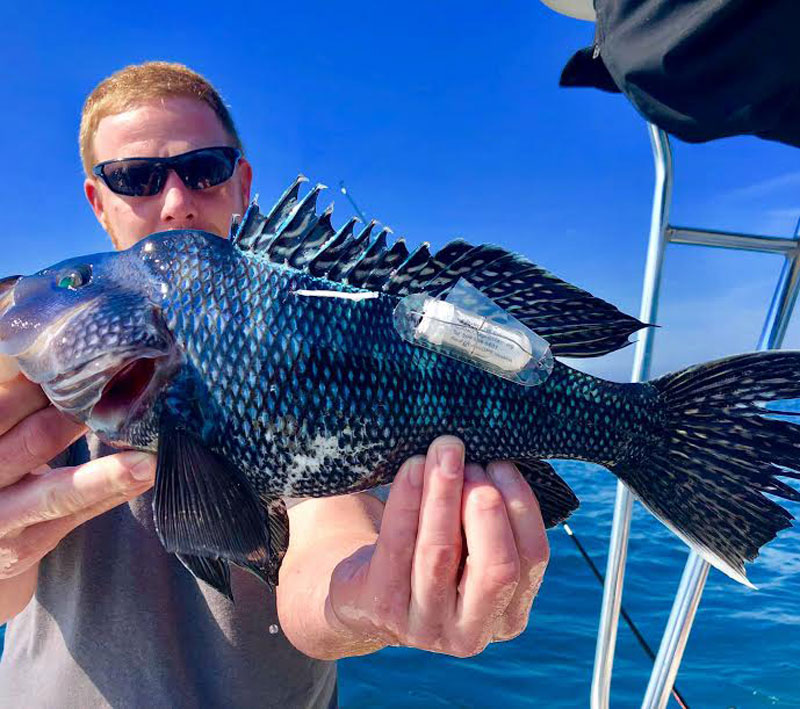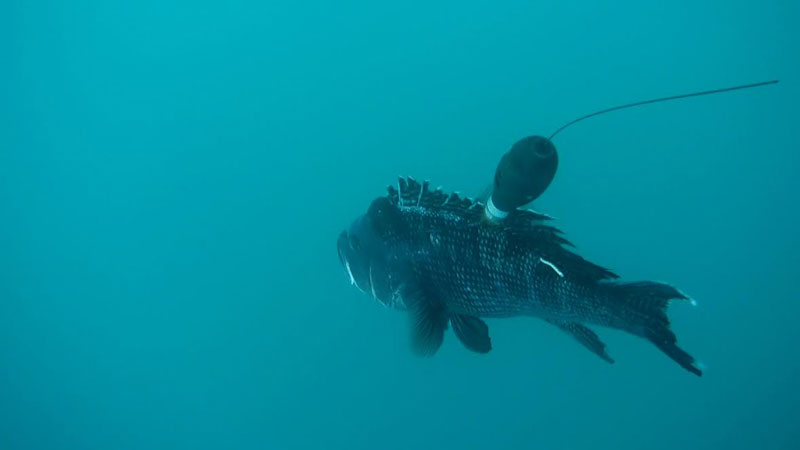Whether you’re fishing for sport, dinner, or profession, when you swing your catch out of the water it’s a triumphant moment – but what if the fish you caught could also contribute to valuable research, even if you're not fishing for stripers while tagging striped bass for the CCA tagging program? The Coonamessett Farm Foundation, CFF, has initiated a research study of the living patterns of black sea bass in the Chesapeake Bay region. While they will be conducting a series of tagging excursions and placing receivers for those tags in strategic locations, they will also be relying on citizen scientists to retrieve the tags and the valuable information they can provide - so your catch could become part of the solution for fisheries science.

Black sea bass have a migration pattern that could potentially shed light on their relationship to habitat usage. We know that these fish head into shallower areas to spawn from March to October, with females capable of producing 30,000 to 500,000 eggs in a season depending on their size. We also know that black sea bass have a reliable loyalty to their foraging locations, which means that if the receivers for the implanted tags are placed appropriately they can potentially make contact with a multitude of tagged specimens inhabiting the area.
“We plan to incorporate a range of electronic tagging devices to take advantage of these characteristics to capture detailed movement patterns and relevant environmental parameters,” says Samir Patel, PhD, head of this study.
There are four scheduled research trips set in the southern Chesapeake Bay region in April and August of 2019 and 2020, each lasting three days. Armed with 48 acoustic telemetry tags, 40 tags that log conductivity, temperature, and depth (CTD tags), four pop-up archival satellite transmitting tags (PSAT) and 2,500 internal anchor “spaghetti” tags, CFF has already successfully implanted six acoustic tags, six CTD tags and one satellite tag on their first mission this past April with Playin Hookey Charters.
With acoustic tags, the tag produces a “ping” and when the animal comes close enough to the receiver. It then collects the data of the animal’s location and stores it until the receiver can be retrieved and the information extracted.

The 2,500 spaghetti tags are to be dispensed to researchers and fishermen, who will hopefully tag as many black sea bass as possible before August of 2020. These types of tags are the ones many anglers are familiar with seeing in various species, “anchored” and visible from the outside of the fish.
When the sea bass are captured for tagging, they will be measured for length and gender will be determined where possible. Each tag will be affixed to the fish with respect to its weight and form. Acoustic tags will be placed on the dorsal centerline between the vent and pelvic fins, while archival tags will be attached to the fish using a manufacturer-supplied harness that can be easily removed after recapture. The satellite tags are designed to release from the fish at a predetermined time, coupled with a failsafe programming to eject after four days without any distinguishable movement.
Each fish will receive one electronic tag and one conventional tag at most, with the expected battery life presumed to be two years, allowing for data collections over several seasons and the fish’s respective migratory cycles. Before fish are returned to the water post-tagging, they will be examined for barotrauma (decompression damage due to rapidly expanding gasses in the fish, which anglers may see when sea bass are reeled up from the depths), and dealt with accordingly.
To reap the rewards of these tagging efforts, acoustic receivers will be integrated at five locations in the Bay, will remain in place for two years, and will be checked every six months. In an attempt to increase their data collection return CFF has also teamed up with the nonprofit Ocean Research Project, which has already initiated their Fish Finder Citizen Science program. This utilizes extensive coverage provided by volunteer vessels deploying receivers in locations along their routes, allowing them to retrieve even more of this valuable data about the migration patterns of the fish.
For the study to be a success, a high recapture rate of conventional and archival electronic tags is needed – and that means the help of private and commercial fishermen. Any anglers in the Chesapeake Bay and surrounding areas who catches a tagged black sea bass is encouraged to alert the CFF.
All tags bear instructions, but the passive spaghetti tags do not need to removed; simply provide a photo of the tag and fish, total length of fish, and the GPS location where the fish was caught. This information can be emailed to [email protected]. The CTD tags should be removed and mailed to: Samir Patel, 277 Hatchville Road East Falmouth, MA 02536.
These tags will provide essential information on both long- and short-distance movement patterns, and the CFF is offering rewards for any tags collected and returned to them. Return of the CTD tags earns you a long-sleeve T-shirt, and you’ll get a beer coozie for spaghetti tag returns. The CFF researchers are relying on the participation of you fishermen out there to help return their tags, so we all can learn from the data and make this study a success – so the next time you enjoy that moment of triumph swinging a black sea bass out of the water, be on the lookout for these tags.
-By Chelsea Co